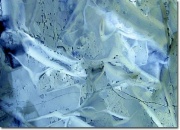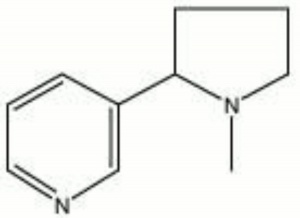Difference between revisions of "Nicotine"
(username removed) |
|||
| (3 intermediate revisions by 2 users not shown) | |||
| Line 2: | Line 2: | ||
== Description == | == Description == | ||
| − | A colorless, oily liquid alkaloid primarily obtained from the dried leaves of the tobacco plant (''Nicotiana tabacum''). Nicotine was named in 1550 for Jean Nicot after he sent tobacco seeds to Paris. It is a highly additive drug that is toxic in large doses. Commercially, purified nicotine is used as an [ | + | A colorless, oily liquid alkaloid primarily obtained from the dried leaves of the tobacco plant (''Nicotiana tabacum''). Nicotine was named in 1550 for Jean Nicot after he sent tobacco seeds to Paris. It is a highly additive drug that is toxic in large doses. Commercially, purified nicotine is used as an [[insecticide|insecticide]], parasiticide, and [[fumigant|fumigant]]. Nicotine turns brown when exposed to light or air. |
| − | + | [[[SliderGallery rightalign|nicotine.jpg~Chemical structure]]] | |
== Synonyms and Related Terms == | == Synonyms and Related Terms == | ||
1-methyl-2-(3-pyridyl)pyrrolidine; 3-(1-methyl-2-pyrrolidinyl)pyridine; Nikotin (Deut.); nicotina (Esp., It., Port.); nicotine (Fr., Ned.); nikotyna (Pol.); nikotin (Sven.); Black Leaf 40; Ortho-N4 dust; Niagara P.A. dust; Nicocide; Nico-dust; Nico-fume; Nicotina; Destruxol orchid spray; Emo-n; Flux MAAG; Fumetobac; Mach-Nic; | 1-methyl-2-(3-pyridyl)pyrrolidine; 3-(1-methyl-2-pyrrolidinyl)pyridine; Nikotin (Deut.); nicotina (Esp., It., Port.); nicotine (Fr., Ned.); nikotyna (Pol.); nikotin (Sven.); Black Leaf 40; Ortho-N4 dust; Niagara P.A. dust; Nicocide; Nico-dust; Nico-fume; Nicotina; Destruxol orchid spray; Emo-n; Flux MAAG; Fumetobac; Mach-Nic; | ||
| − | [ | + | == Risks == |
| + | |||
| + | * Toxic by inhalation, ingestion and skin absorption. | ||
| + | * Combustible. Flash point = 95 C | ||
| + | * Gives off toxic fumes. | ||
| + | * ThermoFisher: [https://www.fishersci.com/store/msds?partNumber=AC181420250&productDescription=L-NICOTINE%2C+99%2B%25+25GR&vendorId=VN00032119&countryCode=US&language=en SDS] | ||
| − | == | + | ==Physical and Chemical Properties== |
Miscible with water. Soluble in alcohols, chloroform, ether, kerosene, oils. | Miscible with water. Soluble in alcohols, chloroform, ether, kerosene, oils. | ||
| Line 25: | Line 30: | ||
|- | |- | ||
! scope="row"| Melting Point | ! scope="row"| Melting Point | ||
| − | | -8.0 | + | | -8.0 C |
|- | |- | ||
! scope="row"| Density | ! scope="row"| Density | ||
| − | | 1.01 | + | | 1.01 g/ml |
|- | |- | ||
! scope="row"| Molecular Weight | ! scope="row"| Molecular Weight | ||
| Line 34: | Line 39: | ||
|- | |- | ||
! scope="row"| Boiling Point | ! scope="row"| Boiling Point | ||
| − | | 123-125 | + | | 123-125 C |
|} | |} | ||
| − | == | + | ==Resources and Citations== |
| − | |||
| − | |||
| − | |||
| − | |||
| − | |||
| − | |||
| − | |||
| − | |||
* ''The Merck Index'', Susan Budavari (ed.), Merck Research Labs, Whitehouse Station, NJ, 12th Edition, 1996 Comment: entry 6365; b.p.=123-125C | * ''The Merck Index'', Susan Budavari (ed.), Merck Research Labs, Whitehouse Station, NJ, 12th Edition, 1996 Comment: entry 6365; b.p.=123-125C | ||
| − | * ''Encyclopedia Britannica'', http://www.britannica.com Comment: "nicotine" | + | * ''Encyclopedia Britannica'', http://www.britannica.com Comment: "nicotine" [Accessed March 26, 2002 |
| − | * Wikipedia | + | * Wikipedia: http://en.wikipedia.org/wiki/Nicotine (Accessed Nov. 9, 2005) - b.p.=247C |
[[Category:Materials database]] | [[Category:Materials database]] | ||
Latest revision as of 12:37, 23 August 2022
Description
A colorless, oily liquid alkaloid primarily obtained from the dried leaves of the tobacco plant (Nicotiana tabacum). Nicotine was named in 1550 for Jean Nicot after he sent tobacco seeds to Paris. It is a highly additive drug that is toxic in large doses. Commercially, purified nicotine is used as an Insecticide, parasiticide, and Fumigant. Nicotine turns brown when exposed to light or air.
Synonyms and Related Terms
1-methyl-2-(3-pyridyl)pyrrolidine; 3-(1-methyl-2-pyrrolidinyl)pyridine; Nikotin (Deut.); nicotina (Esp., It., Port.); nicotine (Fr., Ned.); nikotyna (Pol.); nikotin (Sven.); Black Leaf 40; Ortho-N4 dust; Niagara P.A. dust; Nicocide; Nico-dust; Nico-fume; Nicotina; Destruxol orchid spray; Emo-n; Flux MAAG; Fumetobac; Mach-Nic;
Risks
- Toxic by inhalation, ingestion and skin absorption.
- Combustible. Flash point = 95 C
- Gives off toxic fumes.
- ThermoFisher: SDS
Physical and Chemical Properties
Miscible with water. Soluble in alcohols, chloroform, ether, kerosene, oils.
Hygroscopic. Turns brown with exposure to air and light.
| Composition | C10H14N2 |
|---|---|
| CAS | 54-11-5 |
| Melting Point | -8.0 C |
| Density | 1.01 g/ml |
| Molecular Weight | mol. wt. = 162.23 |
| Boiling Point | 123-125 C |
Resources and Citations
- The Merck Index, Susan Budavari (ed.), Merck Research Labs, Whitehouse Station, NJ, 12th Edition, 1996 Comment: entry 6365; b.p.=123-125C
- Encyclopedia Britannica, http://www.britannica.com Comment: "nicotine" [Accessed March 26, 2002
- Wikipedia: http://en.wikipedia.org/wiki/Nicotine (Accessed Nov. 9, 2005) - b.p.=247C

